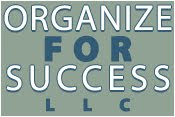 |
|
Organize for Success® Turns 10
|
Today, it's my top 10 tactics to make meetings more productive:
10. Have a clear purpose. Many meetings mistakenly focus on simply updating those in attendance; however, there are plenty of alternative means for conveying updates that are less intrusive to attendees' valuable time. Instead, meetings are most productive when they focus on one of two purposes: (a) discussion or (b) decision-making. If your meeting's purpose is not one of those, could the goal be achieved using alternative means?
9. Be strategic with scheduling. Often, when meetings are set, we indicate a starting time but forget to set a specific ending time; attendees can better plan the remainder of their day if provided an end time in addition to a start time. Further, be cognizant of vacation plans so meetings are not scheduled when many who need to attend will be gone. Finally, avoid scheduling a meeting in the days leading up to a big deadline, especially if the meeting is unrelated to the project coming due, as well as during times when there will be too many distractions for folks to focus on the goal.
8. Trim the fat. Shorten how long you plan to meet and, then, push yourself to accomplish everything on the agenda within that shorter duration by using a timer or having someone serve as timekeeper. Try to end meetings at least 10 minutes before the next hour, like 12:50, 1:50, 2:50, etc, or schedule your meetings in 15-minute blocks, like running from on the hour to quarter 'til the next hour. Attendees will appreciate those few minutes before the next hour to return a quick call, run to the restroom, grab a beverage or gather their thoughts.
7. Invite the right people and only the right people. It is important to include those whose contributions are necessary for accomplishing the meeting's goals: those with the authority to make decisions, those with enough pull in the organization to advocate for what's decided, those with the expertise needed to make informed decisions as well as those necessary for successfully executing said decisions. On the other hand, the Rule of 7 states that "everyone in a meeting over 7 people reduces your ability to make decisions by 10%"; therefore, include only those whose contributions are necessary for accomplishing the meeting's goals as too many attendees will deplete productivity.
6. Have a plan to achieve the meeting's stated purpose. Create a realistic agenda, listing what you truly believe can be accomplished within the scheduled time allowed. Structure that agenda to address the most important issues first. Try to indicate how much time is being allocated for each element listed. Solicit feedback from attendees to make sure anything important is included while lower priorities and unrelated topics get removed.
5. Prepare beforehand. Distribute any supplemental items for review to all attendees beforehand. Share necessary updates via email or your team's collaboration tool before the meeting date. If there is legwork that can be done in advance, completing that beforehand will allow the meeting itself to run more efficiently. As explained by Dana Manciagli in The Triad Business Journal, "proper planning prevents poor performance". Take time to get your ducks in a row before, allowing the time during which folks have come together to be devoted to discussion and / or decision-making.
4. Communicate expectations clearly. If you are leading the meeting, set expectations on how those attending should behave and, then, share those expectations with attendees, whether in writing prior to the meeting or at the start of the meeting. Here are a few suggestions: come prepared, contribute to the discussion with feedback, share your insights as applicable, make sure to ask whatever questions you have and limit technology distractions. Additionally, specifically state guidelines for interjecting during the agenda, like when to ask questions, how to pipe up for brainstorming or at what point it is appropriate to share feedback during a discussion. Think proactively about what situations might arise related to each meeting and be specific with standards set.
3. Take notes. This shows your commitment to the topic, helps you pay attention and enables you to refer back to items covered earlier as the meeting progresses. If you have the agenda beforehand, use that agenda as a framework for filling in notes from the meeting. Highlight what is important, whether via a different color of ink or by blocking that content off separately. Designate each task that must be done as it arises in conversation during the meeting; then, end your meeting notes with a recap, including the highlights, action items and timing of next meeting.
2. Stay focused. Denote on a separate list any issues not on the agenda as they arise. If there is extra time at the end in which attendees want to address those items, feel free to do so; however, it is often the best use of everyone's time to schedule a time for discussing or resolving those issues on a later date.
1. Ensure attendees are accountable for completing tasks. Each action item arising from the meeting needs a deadline for its completion; further, ensuring each task gets completed is more likely when there is someone accountable for its completion. Assign someone to the completion of each task that results from meeting discussions and decide how you'll confirm follow through.
Do you find that meetings steal valuable moments from your day? What are your favorite ways to make meetings more productive? Are there any on this list you'd like to try?

No comments:
Post a Comment